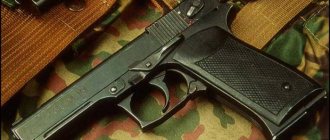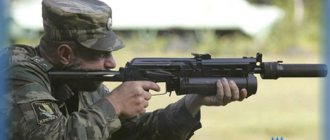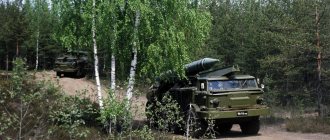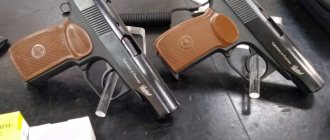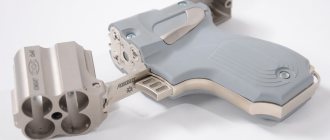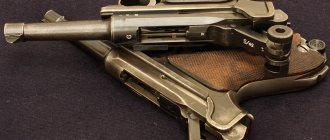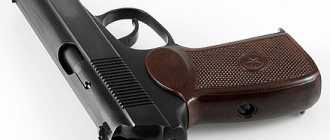Action Air
- News
- Question answer
- Photo and video
- Articles
- Reviews
- Payment, delivery
For children and teenagers, our sport has a wonderful alternative: air gun shooting.
There is a wonderful alternative for children and teenagers in our sport
shooting from pneumatic weapons. However, adults can also practice airsoft, because the discipline is official and competitions at various levels are regularly held in it, up to the World Championships.
Why might this discipline interest you?
- This weapon can be given to children
because there are no age restrictions for shooting from an air pistol, the main thing is that the index finger can reach the trigger and, of course, parents are not against it - Learning to shoot
with an air pistol may well be considered a preparatory stage before switching to military weapons. Having a “toy” copy of a military weapon allows athletes to idle at home, on their own, and for as long as it takes. (It’s no secret that almost every shooter who practices with military weapons has at home an air-powered version of his own pistol, which fits perfectly into a holster and even weighs identical to the prototype!) Of course, we should not forget that the nature of the trigger and the movement of the shutter is significantly different from the real one, since the springs installed on the pneumatic are initially weaker. But this does not in any way prevent us from practicing the technique of some shooting elements. - Headphones are not needed
The shot is not loud, so there is no need to protect your hearing. This does not apply to the protection of the organs of vision - after all, even a harmless plastic ball, when colliding with a hard surface, can fly apart and injure the eyes. - Weapons and “ammunition”
can be legally carried and taken to competitions and training. The main thing is to have a certificate that states that the power of the weapon is less than 2 J and that it is pneumatic.
If you have your own airsoft weapon, you can always practice with it in our shooting club
under the supervision of experienced instructors, just rent a destination or gallery!
We will provide you with mini targets for your air gun! Go to course
By the way, the instructors of our club, as part of the Russian national team, participated in the first World Championship in practical airgun shooting “IPSC Action Air World Shooting Championship 2018”, and will be happy to share their experience with you!
More information about practical shooting with air guns can be found at action-air.ru
Share Go
to news list
Review of the Margolin MC/MCM pistol
Photo: Margolin Pistol / MC / MTsM. Selection-1 Photo: Margolin Pistol / MC / MTsM. Selection-2
The Margolin pistol (MC) is a Soviet small-caliber self-loading pistol. The pistol is intended for training and sports shooting MP-5 at a distance of 25 meters. The pistol uses a 5.6mm (22LR) cartridge. The development of the pistol from 1946 to 1948 was carried out by Mikhail Vladimirovich Margolin. The first batch of five pistols was manufactured in 1947. The Margolin pistol can be found under the abbreviation MC , which stands for “Model TsKIB”, since the documentation and drawings for the production of the pistol were prepared at TsKIB SOO in Tula. According to another version, the abbreviation MC stands for Small-Caliber Target. MCM stands for “modernized” accordingly. The pistol was produced from 1948 to 1979 at the Izhevsk Mechanical Plant (IZHMASH). It is still produced in other modifications today.
Story
Please note that the gun was created by a designer who was completely blind. At the age of 18, during the establishment of Soviet power in Abkhazia, Mikhail Vladimirovich Margolin was wounded in the head, as a result of which he completely lost his sight. After which he took courses as massage therapists, but his love for weapons was so high that, being blind, he first became an instructor in the military office at the First Model Printing House (Moscow) in DOSAAF (OSOAVIAHIM - called at that time), where he was in charge of training models of rifles, grenade, Maxim machine gun, etc. In this office he met brigade commander A.A. Smirinsky, who told Margolin that the country needed sporting weapons, which became Margolin’s way of life. Margolin's blindness was compensated by excellent tactile memory of the fingers and visual imagination. At exhibitions, Margolin studied weapons by touch, created sketches of his ideas from wood and plasticine, and placed weapon mechanisms on plywood. In 1934, OSOAVKHIM suggested that Margolin modernize the TOZ-1 sporting rifle. After which he created the Degtyarev infantry machine gun for firing small-caliber cartridges. In 1948, Margolin became an employee of TsKIB-14, where he worked with Tokarev, who showed him foreign models and domestic developments of small arms. Here he created a rather original TKB-206 pistol chambered for a 9-mm cartridge; the pistol was not accepted for service because the People's Commissariat of Military Industry ordered the designers not to develop pistols for this caliber. Before the war, Margolin created several samples of sports pistols based on the TT pistol chambered for 7.62 and 9 mm calibers, but they did not arouse the interest of the military due to the insufficient accuracy of the pistols. Around the same time, Margolin proposed upgrading the TT pistol to a 9-mm cartridge; the pistol successfully passed tests, but the military did not appreciate Margolin’s work. After the war, Margolin returned to creating sporting pistols. He became interested in the opinions of shooters, turners, and other designers on what a sports pistol should be like. Margolin decided to rigidly attach the pistol barrel to the frame, which was rarely practiced at that time, and move the front sight from the bolt to the pistol frame. As a barrel, Margolin used a small-caliber 5.6 mm barrel from Walter with 6 grooves for its accuracy and low recoil. In the fall of 1947, Mikhail Vladimirovich presented 5 prototype pistols, which were tested by the coach of the Dynamo shooting club F.I. Zhamkov. In 1948, Margolin received an author’s certificate “Self-loading sports pistol of 5.6 mm caliber designed by Margolin.” In 1949, Kalichenko, a master of sports in bullet shooting, won the title of world champion a Margolin pistol This pistol became the main training and sports pistol in the USSR and other countries, even after 60 years it continues to bring gold to athletes in various competitions. The reliability of the Margolin pistol has never been criticized in the weapons world. This wonderful pistol was molded from plasticine by a completely blind man.
Design
The automatic operation of the Margolin pistol works due to the recoil of the free bolt. During a shot, powder gases press on the bottom of the cartridge case, which transfers recoil energy to the bolt, and it rolls back. Since the bullet speed is higher than the shutter speed, the bullet ejects until the cartridge case is extracted. During recoil, a special spring-loaded hook catches the cartridge case for its extraction to the right side. During the recoil of the bolt, the mainspring, which is located under the barrel, is compressed; after the shot, it completes the reloading cycle by pushing the bolt frame back into the firing-locking position with the supply of a new cartridge from the magazine. Also, during the shutter rollback, the firing mechanism is cocked. Since 1952, to make the pistol lighter, it was decided to replace the steel bolt with an aluminum bolt. To power the pistol, single-row box magazines with 5/6/10 rounds are used. For the convenience of loading the magazine, it has a protrusion with which you can compress the spring. Double-action trigger mechanism: pre-cocking the hammer or pressing the trigger harder. The safety of the pistol is ensured by a safety bracket on the left side of the pistol; the safety can act as a slide stop. Pistols produced from 1949 to 1955 did not have a safety lock. Additional safety of the pistol is provided by the trigger mechanism, which does not allow firing a shot when the bolt is not fully locked. The pistol does not have an automatic shutter release after the cartridges have been used up. The trigger has an adjustable release force from 0.5 to 1.0 kg and an adjustable stroke length from 1 to 5 mm. A micrometer sight is used for aiming. There is adjustment of the rear sight horizontally and the front sight vertically. The peculiarity of the pistol is that the rear sight is located on the protruding part of the frame, and not on the bolt, which significantly increases the accuracy and accuracy of shooting, since the front sight is not affected by the recoil of the bolt. The barrel has 6 grooves, the barrel is rigidly attached to the pistol frame, and there are rifling for installing a muzzle brake compensator. Until 1955, pistols were produced with barrel lengths of 180 mm and 140 mm. After modernization, it was decided to install barrels with a length of 152 mm. For ease of shooting, Margolin pistols can be equipped with orthopedic grips, DTK of various models, balancing weights, and “mushroom” handles.
Modifications of the Margolin pistol:
- MTs-1 - sample of the 1948 model
- MCM-modernized Margolin pistol
- MCU-pistol designed for high-speed shooting
- MCM-K “Margot” is a pistol with a shortened barrel up to 98 mm, the modernization of the pistol was carried out by V.A. Yarygin in 1990, serial production started in 1992.
,
- IZH-77 (index GRAU-6P36) - a gas pistol is produced in two calibers: the TK-024 7.6 mm cartridge and the 8x20 mm cartridge. The pistol has been produced since 1993.
“Drill” - modification of MCM-K for firing 5.45x18 mm cartridges, barrel length 78 mm
- MP-449 - export version chambered for 6.35x15.5 (.25ACP)
- EMA10 rifled carabiner.
Technical characteristics of the Margolin / MC / MTsM pistol
| Index | MC-1, MCM, MC |
| Number of shots | 5/6/10 in store |
| Barrel diameter | 0.22LR, 5.6x15.6 mm, 152 mm barrel length |
| Combat rate of fire | no data |
| Sighting range | 50 meters |
| Maximum firing range | no data |
| Initial departure speed | 275-510 m/s |
| Power | 90-130 Joules |
| Automation | blowback recoil |
| Weight | 0.9 kg without cartridges and 0.94 with cartridges |
| Dimensions | Length 126 mm, thickness 20 mm |
Family and childhood
Vladimir Alexandrovich was born into a family of front-line soldiers. The father of the future designer was a combat officer, commander of a machine gun platoon, and after the war he worked as a physical education and military science teacher at school. Vladimir’s mother went through the war as a radio operator and returned to her homeland, the Kirov region, to teach German at school. That's where the parents met. Then my father trained as a dentist and was assigned to Udmurtia, where Vladimir was born in 1950.
Father and mother of V. Yarygin. Photo: Kalashnikov Concern
Vladimir Yarygin's father was interested in weapons and was well versed in them. At that time, handling weapons was quite free, and there were often rifles, captured and Soviet pistols at home. Sometimes the father allowed his sons to shoot too. Then Vladimir developed an interest in weapons, and by the time he was in high school he knew them at a decent level.
In 1973, Vladimir Aleksandrovich graduated from the Izhevsk Mechanical Institute with a degree in mechanical engineer. In the same year, he began working in the department of the chief designer of the Izhevsk Mechanical Plant.
Specifications
Table 1.
| Parameter name | Meaning |
| Caliber, mm | 5,6 |
| Length, mm, no more | 300 |
| Height, mm, no more | 150 |
| Width, mm, no more | 50 |
| Trigger force, N, adjustable | 10…15 |
| Trigger stroke, mm, adjustable | 1…5 |
| Length of the aiming line, mm, no more | 220 |
| Magazine capacity, pcs. | 5 |
| Weight, kg, no more | 1.36 |
Requirements for sports air pistols
Now it’s time to talk about what requirements a pistol must meet in order to be called a sports pistol. As mentioned earlier, a lot depends on the type of sporting event at which the weapon is planned to be used. However, there are several important points that any sports pistol must meet:
- type of impact mechanism - compensated or spring;
- initial bullet speed – no more than 120 m/s (but not less than 90 m/s);
- muzzle energy indicator (up to 7.5 J);
- caliber of ammunition used - 4.5 millimeters;
- barrel type – rifled (with at least 1 groove per centimeter);
- release type - with pre-cocking (no more than 500 grams);
- Dimensions – no more than 420 mm in length, 200 mm in height and 50 mm in width;
- material – metal, wood, rubber (plastic guns are not allowed everywhere);
- fuses - automatic or mechanical.
Another important point of admission to competitions is the absence of third-party modifications on the pistol. And we are talking not only about the “body kit” that gives the shooter an advantage or affects the technical characteristics of the model.
Very often, athletes are not allowed to compete simply because they install an additional choke on their pistol or cut the barrel. None of the judges will test the pistol to determine whether it meets the standards not only according to the passport, but also in reality.
